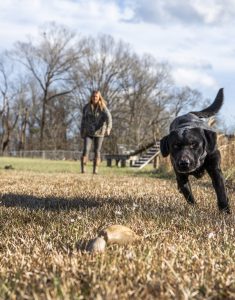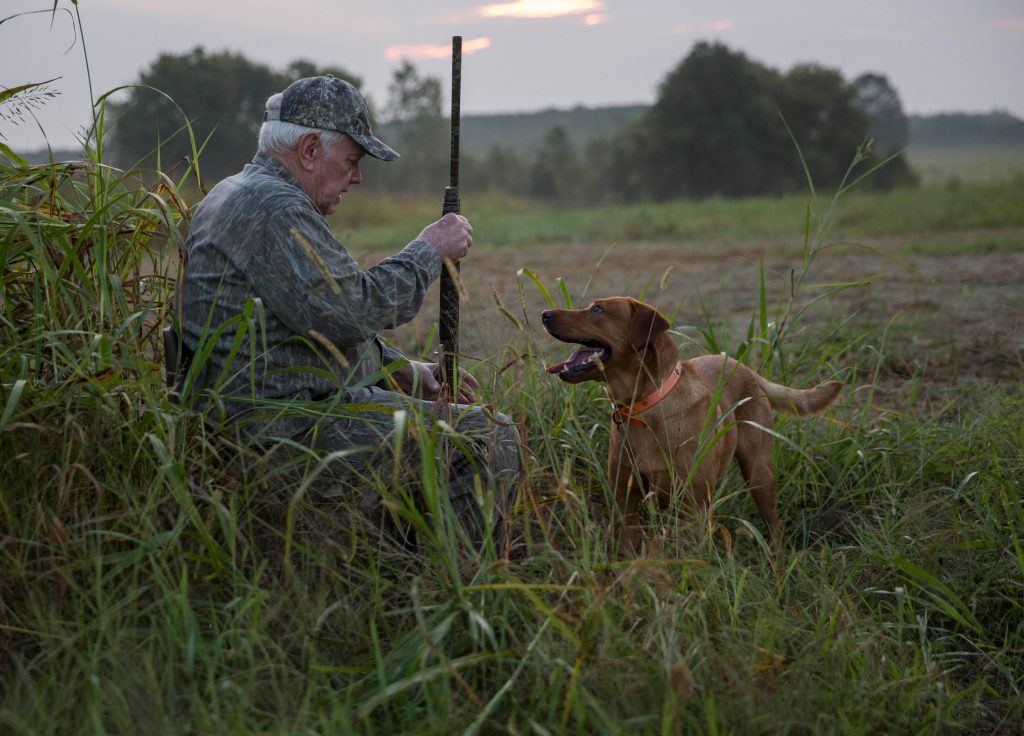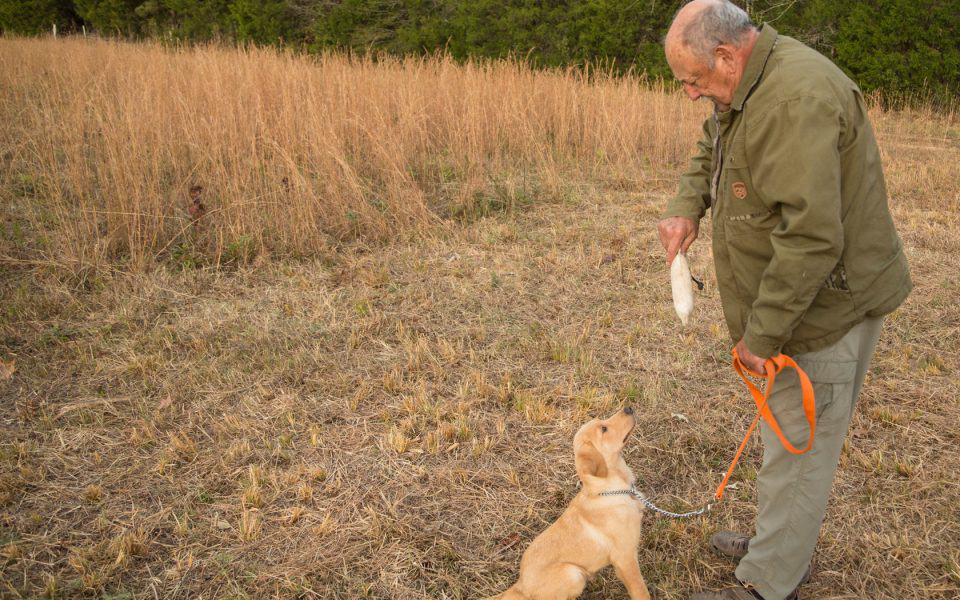A “barrier,” as defined by me, is any type of change in the terrain on the grounds which one is hunting or training upon. It could be a simple change in the color of the grass, a change from tall grass to short grass or vice versa, a change from a grassy field to a wood line, a mowed path or a game trail running thru a field, a wooded or a cutover area, a graveled or a paved driveway or a path, and so on. Now that you have read my definition of a barrier. The logical question is: How do you know when your pup has hit a barrier? As you read the different scenarios that follow, you will discover the one key thing your pup will do when it hits a barrier.
Changes in Color of Grass
 In this training exercise, we assume you are working an area where the grass changes color from a dead brown to green or vice versa. For purposes of this situation, you and your pup are standing in green grass and you throw a dummy from the green grass area into the adjacent dead grass area. You align pup’s head and spine toward the dummy and cast your pup. As he approaches the color change, he stops and almost immediately starts to run up and down the line where the green grass meets the brown-dead grass. This is the key indicator that a dog, by my definition, has hit a “barrier” that he will not cross. What do you do? How do you correct this problem?
In this training exercise, we assume you are working an area where the grass changes color from a dead brown to green or vice versa. For purposes of this situation, you and your pup are standing in green grass and you throw a dummy from the green grass area into the adjacent dead grass area. You align pup’s head and spine toward the dummy and cast your pup. As he approaches the color change, he stops and almost immediately starts to run up and down the line where the green grass meets the brown-dead grass. This is the key indicator that a dog, by my definition, has hit a “barrier” that he will not cross. What do you do? How do you correct this problem?
You don’t yell and scream and pull your hair out; instead, the right thing to do is recall the pup, or go out to him, heel him back very close to the barrier, align him, and cast him so that he breaks thru the barrier, retrieves the dummy, and delivers it to hand. Next, you gradually increase the distance from the barrier until, upon being sent, the pup is running through this barrier at any distance. Before you finish, reverse the situation and throw the dummy while standing in the brown grass and have your pup retrieve from the green grass.
Short Grass and High Grass
Now we are training in a different area on your training grounds. Here we have a situation where low cover (short grass) meets high cover (high grass) area. For our purposes, you are standing in low grass and you throw a dummy into the high grass. You align your pups head and spine in the direction of the dummy and cast them. They get to the high grass, stop and then start to run back and forth along the edge of the high cover. Your pup has, again by my definition, hit a different type “barrier” and, as before, does not know what to do-so they continue to run up and down the barrier. What should you do?
You can either recall pup or quietly walk out to him, collect him, realign him very close to the high cover, and then cast pup through the barrier and into the cover. Encourage him to hunt dead until he finds the dummy and delivers it to hand. The next step is to lengthen the distance by backing up a few yards, throwing a dummy into the high cover, realigning pup and again releasing him. The pup should pick the dummy and deliver to hand. Again, lengthen the distance and repeat the scenario until without hesitation the dog breaks through the barrier and retrieves the dummy. Before you finish, reverse the situation and throw the dummy from the high grass into the low grass and have the pup retrieve the dummy.
Field and Wood Line
 In this training exercise you are working your pup in an area where the field you are training in meets a wood line. You align your dog, throw a dummy into the woods and release your pup. Pup goes out on a good line, but stops short of the dummy and begins to run up and down the wood line. Once again, albeit a different situation, the pup has hit a barrier. As before, you recall the pup or walk out to him, collect him, heel him up close to the barrier-the wood line-using your whistle command the pup to sit. You line their head and spine in a direction pointing toward the dummy and cast him into the wood line. The dog should quickly learn to enter the woods, make the retrieve, and deliver to hand. As before, you incrementally increase the distance until the pup is, at all distances, running into the barrier, picking the dummy and delivering to hand. Before you finish, reverse the episode and have them retrieve from the timber out into the field.
In this training exercise you are working your pup in an area where the field you are training in meets a wood line. You align your dog, throw a dummy into the woods and release your pup. Pup goes out on a good line, but stops short of the dummy and begins to run up and down the wood line. Once again, albeit a different situation, the pup has hit a barrier. As before, you recall the pup or walk out to him, collect him, heel him up close to the barrier-the wood line-using your whistle command the pup to sit. You line their head and spine in a direction pointing toward the dummy and cast him into the wood line. The dog should quickly learn to enter the woods, make the retrieve, and deliver to hand. As before, you incrementally increase the distance until the pup is, at all distances, running into the barrier, picking the dummy and delivering to hand. Before you finish, reverse the episode and have them retrieve from the timber out into the field.
Mowed Paths and Game Trails
In another example, you work you’re your pup in an area where there are mowed paths and/or visible game trails. You throw a dummy so that it lands in an area where the dog must cross a cleared path or a game trail to complete the retrieve. With the pup sitting, you align their head and spine in the direction of the dummy line and release them. The dog goes out on a good line, showing lots of drive, but stops short of the dummy and begins to run up and down the mowed path or game trail.
Albeit a different type situation, again the pup has hit a barrier. Rather than scream, yell or shout, you recall the pup or walk out to him, collect him, heel him up close to the barrier. Using your whistle, you command the pup to sit, line pups head and spine toward the dummy and cast him so that he has to cross the mowed path or game trail to make the retrieve. In short order the pup should cross the barrier and pick the dummy and deliver to hand. Next, as before, you incrementally increase the distance until the pup is, at all distances, running thru the barrier, picking the dummy and delivering to hand.
Crossing a Gravel or Paved Driveway or Walking Trail
Lastly, you are training in an area that has a gravel or paved driveway or walking trial running thru it. You heel your pup, have them sit, then throw a dummy so that it lands on the other side of a graveled or paved walking trail. You align his head and spine in a direction toward the dummy and release him. The pup takes a good line but upon approaching the trail, he slams on the brakes and begins to run up and the edge of the “barrier.”
What do you do? Do you run out, grab the pup by the scuff of the neck and give him a good tongue lashing or in some other way let him know in no uncertain terms that you are dissatisfied with his performance. Absolutely not! Why, because the pup must understand the task at hand before he can be corrected for not doing what he does not understand. Instead, you recall them or calmly walk out to him, collect him, and heel him up close to the barrier. Using your whistle, you command the pup to sit, line his head and spine in the direction of the dummy and cast him so that he has to cross the mowed path or game trail to make the retrieve. In short order, the pup should cross the barrier, pick the dummy and deliver it to hand. Again, as before, continue to incrementally increase the distance until the pup is, at all distances, not hesitating to run through the barrier, picking the dummy and deliver it to hand.
Conclusion

To many folks the content of the above training scenarios may appear to be redundant and probably boring, but each of the above situations present a different training exercise on a different type barrier that needs to be addressed. Why you ask? Because the pup needs be exposed to as many potential problem areas as possible. You never know what you and your pup will encounter during your days in the field and the more exposure they get in training the better they will be prepared to handle actual hunting situations arising in the field.
They are not going to develop into a well-disciplined hunting dog until they have been exposed to many different situational issues in training and later transitioned to actual hunting situations in the field. Furthermore, while each of the above situations are in some ways are very similar, in other ways they are very much dissimilar. In fact, all barrier types are different and the only common thread through out is the corrective action(s) taken by the trainer to teach the pup to drive through different barriers. The important thing to understand is that exposure to many different obstacles builds a pup’s confidence in dealing with barriers in training and in the field, while simultaneously building his trust in you as his trainer/handler.
Bill Gibson is the Director of Gundog Operations and Kennel Master at Mossy Oak Kennels.








